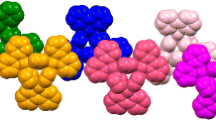Abstract
The novel 3-fold symmetric 1,3,5-tris(1H-imidazol-2-yl)benzene, having a propensity for a 3-fold salt formation by hydrogen bonding at the periphery, was prepared from oxidation of the hexahydro imidazole precursor. The transformation proved difficult and, of the many reagents tried, only barium manganate and o-iodoxy benzoic acid were successful. The oxidation to the aromatic 1,3,5-tris imidazolyl benzene produces dramatic changes, particularly when the X-ray structures of their tris-TFA (trifluoroacetic acid) salts are compared. While the hexahydro precursor exhibited a herringbone type arrangement in the crystal, the oxidation resulted in almost co-planar molecules that formed parallel stacks separated by 3.57 Å between the atoms in separate planes. 1,3-Bis(1H-imidazole-2-yl)benzene is an attractive core unit for assembly using a variety of auxiliaries. Several attempts to complex the bis-imidazole with organic acids failed. These efforts lead to the serendipitous discovery of a novel tetrameric assembly, mediated by water molecules, which was confirmed by crystallization of the bis imidazole from water.
Index Abstract
Differing Patterns in the Self-Assembly of Radially Anchored Imidazoles, 1,3,5-Tris(1 H -imidazol-2-yl)benzene and 1,3-Bis(1 H -imidazol-2-yl)benzene
A. Infinite stacks of the TFA salt from 1,3,5-tris(1H-imidazol-2-yl)benzene with a separation of 3.57 Å between atoms in separate planes (The TFA moiety has been omitted for clarity).
B. Tetrameric assembly of 1,3-bis(1H-imidazol-2-yl)benzene, mediated by water molecules.
Differing Patterns in the Self-Assembly of Radially Anchored Imidazoles, 1,3,5-Tris(1 H -imidazol-2-yl)benzene and 1,3-Bis(1 H -imidazol-2-yl)benzene
Y.B.R.D. Rajesh, (2) Subramania Ranganathan, (2)* Richard D. Gilardi (1,3) and Isabella L. Karle, (1)*
(1) Laboratory for the Structure of Matter, Naval Research Laboratory, Washington, D.C. 20375-5341
(2) Discovery Laboratory, Organic III, Indian Institute of Chemical Technology, Hyderabad 500 007, India
(3) Retired








Similar content being viewed by others
References
(a) Ranganathan S, Muraleedharan KM, Chandrashekar Rao Ch, Vairamani M, Karle IL, Gilardi RD (2001) Chem Commun 2544; (b) Karle IL, Gilardi RD, Chandrashekar Rao Ch, Muraleedharan KM, Ranganathan S (2003) J Chem Crystallogr 33:727; (c) Karle IL, Rajesh YBRD, Ranganathan S (2005) J Chem Crystallogr 35:835
Fan J, Sun W-Y, Okamura T-A, Tang W-X, Ueyama N (2003) Inorg Chem 42:3168 and references cited therein
Kraft A, Osterod F, Frohlich R (1999) J Org Chem 64:6425
Nam SR, Kim H-J, Sakamoto S, Yamaguchi K, Hong J-I (2004) Tetrahedron Lett 45:1339
(a) Kraft A, Reichert A (1999) Tetrahedron 55:3923; (b) Kraft A, Reichert A, Kleppinger R (2000) Chem Commun 1015
Kraft A (1999) Perkin Trans I 705
Kraft A, Osterod F (1998) Perkin Trans I 1019
Kraft A, Grimsdale AC, Holmes AB (1998) Angew Chem Int Ed 37:402
Grawe T, Schrader T, Zadmard R, Kraft A (2002) J Org Chem 67:3755
Hughey JL IV, Knapp S, Schugar H (1980) Synthesis 489
Nicolaou KC, Mathison CJN, Montagnon T (2004) J Am Chem Soc 126:5192
Levesque G, Gressier J-C, Proust M (1981) Synthesis 963
A survey of disorders reported in the Cambridge Crystallographic Data Centre shows that 25% of the reported structures containing CF3 groups are disordered. “Twins, Disorders and other Demons”, Anderson JLF, Deschamps JR, Gilardi RD, George C (2001) Crystal Eng 4:131
Karle JM, Karle IL (1989) Chemotherapy 1081
Anastassiadou M, Mouysset GB, Payard M (2000) Synthesis 1814
Amemiya Y, Miller DD, Hsu F-L (1990) Synth Commun 20(16):2483
Baltork IM, Zolfigol MA, Alibeik MA (2004) Tetrahedron Lett 45:8687
Kraft A, Frohlich R (1998) Chem Commun 1085
Acknowledgement
SR and Rajesh are grateful to Department of Biotechnology, New Delhi for financial assistance. Work performed at the Naval Resesearch Laboratory was supported by the Office of Naval Research.
Author information
Authors and Affiliations
Corresponding author
Additional information
Richard D. Gilardi—Retired.
Rights and permissions
About this article
Cite this article
Rajesh, Y.B.R.D., Ranganathan, S., Gilardi, R.D. et al. Differing Patterns in the Self-Assembly of Radially Anchored Imidazoles, 1,3,5-Tris(1H-imidazol-2-yl)benzene and 1,3-Bis(1H-imidazol-2-yl)benzene. J Chem Crystallogr 38, 39–48 (2008). https://doi.org/10.1007/s10870-007-9286-6
Received:
Accepted:
Published:
Issue Date:
DOI: https://doi.org/10.1007/s10870-007-9286-6




